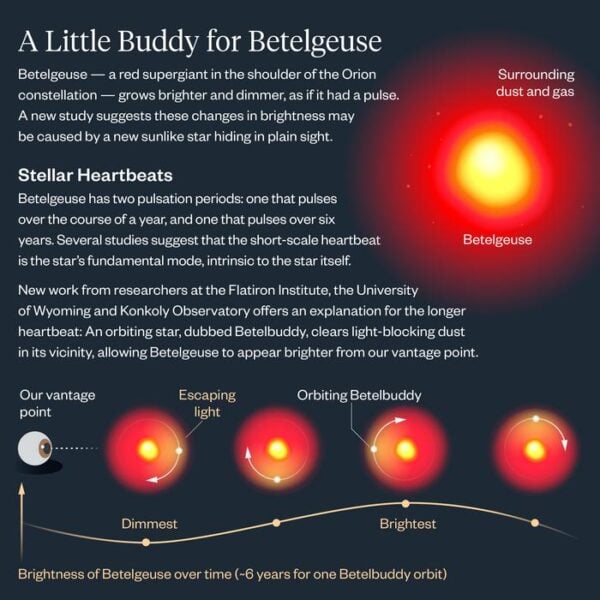Astronomers have uncovered evidence suggesting that Betelgeuse, one of the night sky’s brightest stars, may have a stellar companion influencing its enigmatic brightness variations. This finding challenges previous theories about the star’s potential supernova status.
Summary: New research proposes that Betelgeuse’s long-term brightness changes are caused by an orbiting companion star, dubbed “Betelbuddy,” rather than indicating an imminent supernova explosion.
Estimated reading time: 5 minutes
In a surprising twist to the ongoing saga of Betelgeuse’s fluctuating brightness, researchers have proposed a new explanation that could rewrite our understanding of this celestial giant. A study accepted for publication in The Astrophysical Journal suggests that an unseen stellar companion, playfully nicknamed “Betelbuddy,” may be responsible for the star’s perplexing luminosity changes.
Betelgeuse, the tenth-brightest star in the night sky, has long captivated astronomers and stargazers alike. Its reputation as a dying star on the brink of a spectacular supernova explosion has only added to its allure. However, this new research challenges that narrative, offering a more nuanced explanation for the star’s behavior.
The Betelbuddy Hypothesis
Jared Goldberg, a Flatiron research fellow at the Flatiron Institute’s Center for Computational Astrophysics and the study’s lead author, explains the team’s findings: “We ruled out every intrinsic source of variability that we could think of as to why the brightening and dimming was happening in this way. The only hypothesis that seemed to fit is that Betelgeuse has a companion.”
This companion star, formally named Alpha Ori B but affectionately called “Betelbuddy” by the researchers, is thought to orbit Betelgeuse, acting like a celestial snowplow. As it moves through its orbit, it pushes aside light-blocking dust, temporarily increasing Betelgeuse’s apparent brightness from Earth.
The study, co-authored by Meridith Joyce of the University of Wyoming and László Molnár of Konkoly Observatory, combines observational data with advanced computer simulations to support this hypothesis.
Decoding Betelgeuse’s Heartbeat
Betelgeuse is known as a variable star, exhibiting regular patterns of brightening and dimming. These patterns, often likened to a heartbeat, occur on two distinct timescales: one slightly longer than a year, and another spanning about six years.
Understanding which of these “heartbeats” represents Betelgeuse’s fundamental mode of pulsation is crucial for predicting its future. If the longer-period variation is intrinsic to the star, it could indicate an impending supernova. However, if it’s caused by an external factor – like a companion star – it would be classified as a long secondary period.
The research team explored various possibilities to explain this long secondary period, including internal stellar processes and magnetic field fluctuations. However, their analysis consistently pointed to the presence of a companion star as the most plausible explanation.
“Nothing else added up,” Goldberg states. “Basically, if there’s no Betelbuddy, then that means there’s something way weirder going on — something impossible to explain with current physics.”
The Hunt for Betelbuddy
While the evidence for Betelbuddy is compelling, direct observation remains elusive. The researchers estimate that the companion could be a star up to twice the mass of our sun, though its exact nature is still uncertain.
Meridith Joyce offers an intriguing alternative hypothesis: “A more exotic hypothesis I personally like, though the opinions of my co-authors may differ, is that the companion is a neutron star — the core of a star that has already gone supernova. However, in that case, we would expect to see evidence of this with X-ray observations, and we haven’t. I think we should look again.”
The team is now planning to attempt direct imaging of Betelbuddy, with a potential window of visibility around December 6. “We need to confirm that Betelbuddy actually exists, since our result is based on inference, not on direct detection,” says Molnár. “So we’re working on observation proposals now.”
Implications for Stellar Science
This research not only sheds new light on Betelgeuse but also demonstrates the power of collaborative, interdisciplinary science. The study combined expertise in space-based observations, massive star simulations, and stellar modeling to arrive at its conclusions.
The discovery of a potential companion to Betelgeuse, if confirmed, would have significant implications for our understanding of stellar evolution and the life cycles of massive stars. It underscores the complexity of these cosmic giants and the intricate interplay between stars in binary or multiple systems.
As we continue to unravel the mysteries of Betelgeuse, this research reminds us that even well-studied celestial objects can hold surprises. In the words of László Molnár, “That is what excites me the most.”
Quiz: Test Your Knowledge on Betelgeuse and Its Companion
- What is the nickname given to Betelgeuse’s proposed companion star?
- How does the companion star potentially affect Betelgeuse’s brightness?
- What is a “long secondary period” in the context of variable stars?
Answers:
- Betelbuddy
- It acts like a snowplow, pushing light-blocking dust out of the way
- A pattern of brightness variation caused by an external factor, such as a companion star
Glossary of Terms
- Red Giant: A large, cool star in a late phase of stellar evolution
- Supernova: A powerful and luminous stellar explosion
- Variable Star: A star whose brightness fluctuates as seen from Earth
- Fundamental Mode: The primary, intrinsic pulsation pattern of a star
- Long Secondary Period: A longer-term brightness variation in some variable stars, often of unclear origin
- Binary System: A pair of stars orbiting around their common center of mass
Enjoy this story? Get our newsletter! https://scienceblog.substack.com/
If our reporting has informed or inspired you, please consider making a donation. Every contribution, no matter the size, empowers us to continue delivering accurate, engaging, and trustworthy science and medical news. Independent journalism requires time, effort, and resources—your support ensures we can keep uncovering the stories that matter most to you.
Join us in making knowledge accessible and impactful. Thank you for standing with us!

